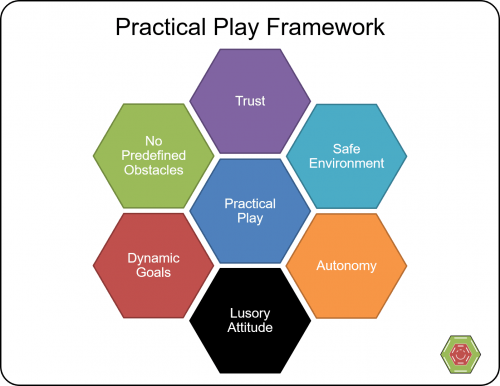Serious games and serious play both have an issue. The issue is, the word serious. It sounds far too, well, serious!
I have heard lots of people complaining about this, somewhat misunderstanding what the serious refers to. “Why can’t it be fun, not serious?” “Serious does not sound fun, that can’t be right!”
Obviously the serious in these terms is there to differentiate entertainment focused and non-entertainment focused games. That is to say, games that we play just to enjoy the experience and games that we play to achieve something, such as learning and skills acquisition.
I have already seen an active campaign to move serious games and even gamification towards the term “Applied Games”. I have thought of offering “Applied Play”, but I like alliteration, so offer you all “Practical Play”
This is the application of play for practical purposes. Considering play is generally not a practical form of anything, this should be fairly counter-intuitive and thus awesome!
The Practical Play Framework
So from now on, this is my “Practical Play Framework” – not “A framework for creating play-like systems”
See what I did there?
Practical Play Elements
- Trust
- Trust is massively important in any type of play, practical or otherwise. You have to trust other players and the environment within which you are playing. This is a judgement free zone.
- Safe Environment
- Following on from trust, the safe environment is another huge part of play. In a more practical setting, we are looking for an environment that does not punish failure and where there is no expectation of success (or at least no expectation that you are riht or wrong, just that you will learn!)
- Autonomy
- Autonomy is important because you can’t be forced to play! You need to allow people to approach everything in their own way and allow experimentation and creativity in solving problems.
- No Predefined Obstacles
- Contrary to popular belief, play is not devoid of rules, however, the rules are more meta or implicit in play. Think of them as the difference between gravity being an implicit rule compared to “you can only touch the ball with a funny stick to get it in the hole”, which is a much more explicit rule and indeed a predefined obstacle.
- Dynamic Goals
- Play doesn’t usually have specific goals, but practical play does need some. There may be an overall goal, such as “Design a new process for doing expenses”. During the practical play though, goals need to be adaptable, fluid and dynamic. No waterfall project managers here, please!
- Lusory Attitude
- This is probably the most essential element. Lusory attitude is just a playful mindset, approaching the task with an open and playful frame of mind. Coming to the table with a “this is stupid” attitude will not help at all. Be open to the experiences.
So there you go. Now let’s play!
Similar Posts:
- A framework for creating play-like systems
- Encourage Play, Don’t Force Fun
- Why “undo” is critical to ludic design


Also published on Medium.


Hi and thanks for sharing your thoughts. I, personally, prefer “applied games” as it is an “on point expression” of what games actually do in a serious context. We don’t design them for pure entertainment but “apply” them to something different. It can actually be anything and will still remain a game (or at least is based on game technology).
In Germany we sometimes also use the word “applied interactive technologies” (APITs) which I think covers an even broader spectrum of applications.
I think we can agree on that “serious games” is a stupid term that should be eliminated once and for all.